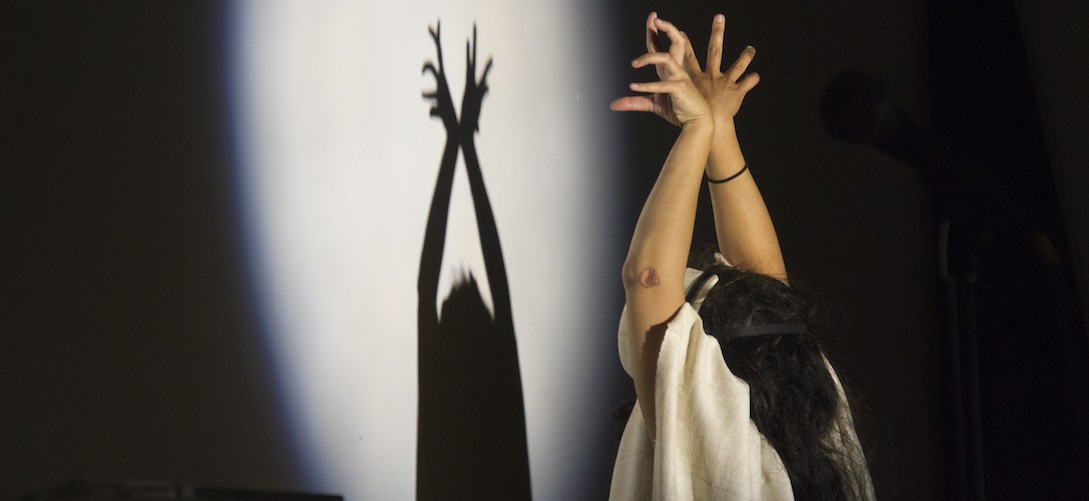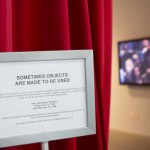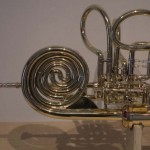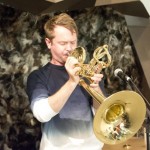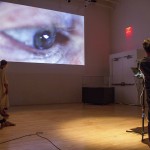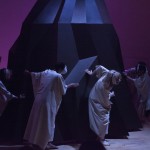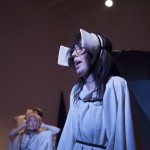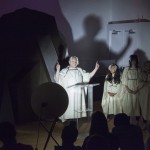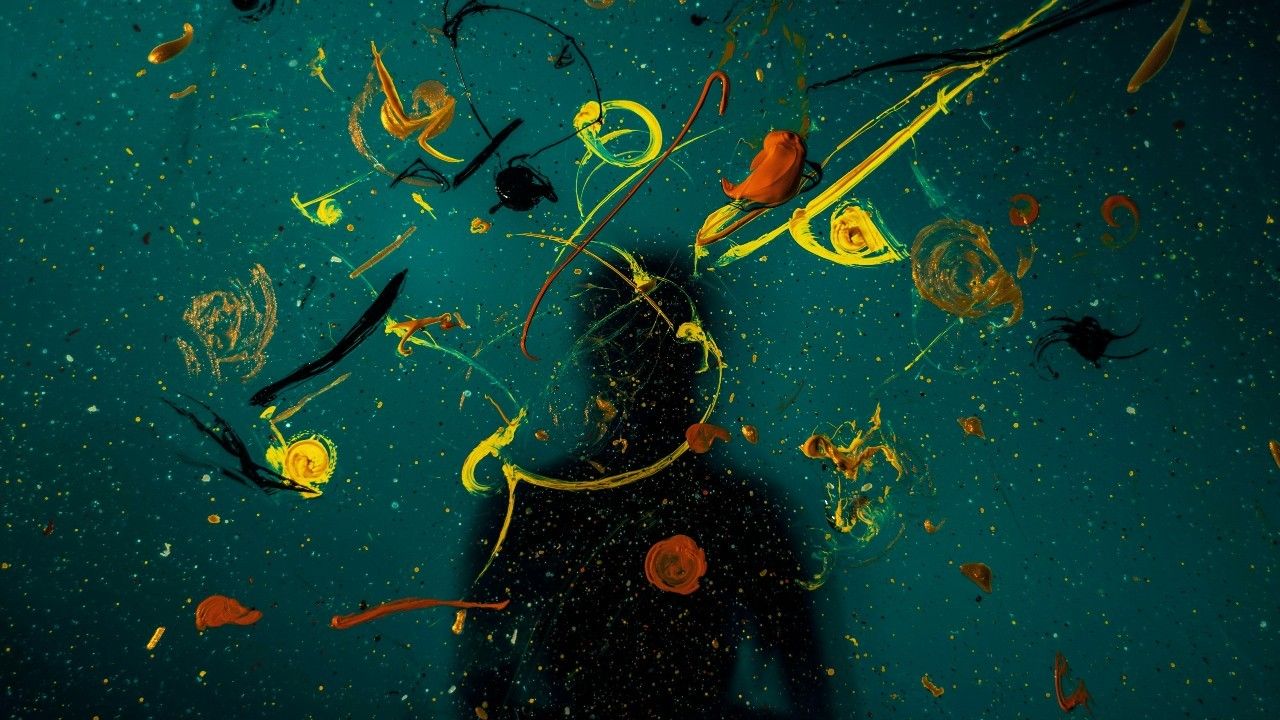Actor Tony Torn talks to artist Jeanine Oleson about her experiments moving opera off the proscenium stage and into the interactive space of the New Museum.
Jeanine Oleson is an artist whose practice incorporates interdisciplinary uses of photography, performance, video and installation work. As part of an intensive residency at the New Museum, Oleson created a multifaceted exploration of different kinds of voices — human, instrumental, political, and eternal — entitled “Hear, Here.” The exhibition featured a series of interrelated works — including a video installation, a publication, public programs, workshops, and set pieces for an experimental opera written and directed by Oleson — that premiered in the New Museum theater in June 2014. We asked actor Tony Torn — who performed in “Hear, Here” — to talk to Oleson about the show’s complicated journey.
TONY TORN: So here I am, Tony Torn, sitting with Jeanine Oleson, and we’re going to talk about the process of creating her experimental opera project “Hear, Here.” So, Jeanine Oleson, hey!
JEANINE OLESON: Hi!
TONY: You and I first met in the Civilians’ Research and Development Group when you were in the early stages of working on the piece that would eventually become “Hear, Here.” Back then, you were describing a piece that was very focused on examining the audience. Is that pretty much where the project started, with the audience?
JEANINE OLESON: It started because I had been doing interviews with hardcore fans or cultural connoisseurs of performing arts, mostly opera. That project funneled itself into something called “The Rocky Horror Opera Show,” a concert where the audience was dressed up, but the singers were not. That became a two-channel video piece — looking at the audience and looking at the performers — that we presented as part of the New Museum exhibition.
Those things are incompatible ideas but I like jamming them together, and being like, “They’re gonna be together. We’re gonna deal with them together, actually.”
TONY: How did you turn those initial interviews into “The Rocky Horror Opera Show?”
JEANINE: Whenever I interviewed people — especially opera buffs — they would always talk about how their bodies felt from listening to singers, having the sublime moment, you know? The only way they could describe it was through their bodies. Everything else was often very organized — the way that they would organize what was good, what was not good. But then when they had that moment, it would be—
TONY: When the sublime hit?
JEANINE: Yeah, it would just hit. And so then I was thinking about what it could be to create a situation where amazing singers could create that moment. But at the same, audiences would be bound in a different contract to the performer than a normal one, where they can just sit there and that’s fine. In this case, they were all wearing costumes based on the arias, which kind of came down to “rich people” and “poor people,” and Carmen and Pagliacci — those were the characters. For me, it was just like, “How do I take that experience of the sublime and give it a space to happen?” Some of the audience that showed up were the buffs, and then a portion of them had probably never been to an opera. I was interested in the tweaking of a concert experience through something like “Rocky Horror,” which has a kind of cult following too.

TONY: Right. So part of the two-channel video piece was watching the audience come into a room with costumes and try them on?
JEANINE: Yeah. Before they went into the theater, they had dressers. Pushy dressers.
TONY: Yes. Love it.
JEANINE: They were like, “We’ll put you in a costume. What’d’ya wanna be. What’d’ya wanna be.” And they would funnel them into the performance space. Most people were kind of excited about it, even if they weren’t generally someone who would wear a costume.
TONY: And the audience members in costume were encouraged to behave like “Rocky Horror” audiences, to interact with the performance as it happened. What sort of stuff were they encouraged to do?
JEANINE: You know, I actually didn’t encourage anyone to do anything. I just said at the beginning, “You can do whatever you want.” And it said on the program, “You are being videotaped, but you can do what you would like.” That was all. There weren’t really prompts. There were people that I knew there, and there were some people who knew what their costumes represented — which arias they applied to. Other people didn’t. There were people who knew the chorus parts for certain songs and would sing them, or come out and confront the singers as if they were in another role. That was more the buffs who did that.
One girl thought it was a “Rocky Horror Picture Show” thing at the museum, and so she showed up to be Janet. But then she went up and put her boa on one of the singers and was perfectly happy about that. Someone else came up and took a selfie with a singer, which actually was the funniest moment in a way, because it was a moment where you’re like, “Oh, that’s actually what people would want to do if they could be on stage. They’d take a selfie with the performer.” People threw a lot of things. The whole room had this vibration of, “Anything could happen! What are we gonna do?!”
TONY: Having put that interview material into that part of the process, what’s the relationship of “Hear, Here” to “The Rocky Horror Opera Show?”
JEANINE: I was thinking a lot about audience for “The Rocky Horror Opera Show.” But I was also thinking about language. And that spun off and became its own thing. I started to think more about the idea of giving agency. “Hear Here” was more about what happens when you make this language for performers bodies to perform and react to. Really awful language, often.
TONY: Like the political language, for example.
JEANINE: Yeah. “Ladies and gentlemen, they say that one-third of the working population in Africa will die of AIDS over the next 20 years..” And then, of course, you’re all answering this horrid thing that Angela Merkel said with “WORKING POPULATION.” You’re watching the performers deal with and grapple with a kind of language that is about the problem that we live in, relegating humans to entire continents and death percentages.
TONY: Right, the way ideas travel like infectious diseases. They set the tone. The politicians set the tone. Or these guys who are doing business seminars create these ideas or these ways of framing things. And people absorb them, even if they’re not really aware of it. Pretty soon you’re all saying, “Oh yeah, well, it’s a fact that 25 percent of the population of Africa will die of AIDS.”
JEANINE: But then, in terms of the performance, thinking, “What does it mean if you take that same material and present it in a different situation?” It makes it suddenly funny and not at all funny all at once, in terms of thinking about neo-liberal policies that are controlling our lives. Because that language all started from the G8. And thinking about the G8 and economic imperialism, well, it’s backfiring now. You know?
TONY: So in “Hear, Here” you have these totemic, paradoxical objects that you created. And they really anchor the piece. There’s the mountain that is also a cave, for example. There’s the light that’s based on the shape of the eye. The ear/horn. When did you start becoming fascinated with that sort of paradoxical relationship?
JEANINE: I’d been thinking about the idea of reversing. Some of them, it’s about reversing the order of the body senses. I think about that as being synonymous with having to watch performers grapple with language about awful things, and having to deal with your own sense of consciousness about what they’re doing. Or thinking about your own agency in hearing something. The mountain means one thing; it means The Mythic. It means Conquest and Imperialism. And the cave is something unknown. It also points to Plato and the making of knowledge. Those things are incompatible ideas but I like jamming them together, and being like, “They’re gonna be together. We’re gonna deal with them together, actually.”
TONY: So do you think that the earlier piece that came out of this process — “The Rocky Horror Opera” — was more about the audience than the performers? And then it seemed like you got more interested in what performers would do with these totemic objects.
JEANINE: Yeah, definitely. Being interested in the audience in that way, I let go of it and let it become, “How can I actually find a way to engage them in the ideas?” That became more interesting to me. Or to engage them in the ideas of what’s being performed, and also with what you all were using — the horn, the light, these things that have meaning beyond their use. The difference between sculpture and a stage set, or having it be the same thing.
TONY: A lot of these objects were also taken out of the context of the play and presented in a gallery setting as objects, so they had a different life. They were kind of moonlighting as theatrical objects. How much of the piece came together once you had the actors?
JEANINE: Well I had most of it written, but then once it started to be workshopped, I was taking things in and taking things out. Once you started to learn the lines, though, I did not do that too much. I knew it was too complicated.
TONY: Well yeah, but my experience of the piece is that it was modular. I just had a sense that there were a lot of different objects in play. There were performance objects, as opposed to physical objects. You had all these pieces, these discrete pieces. Can you talk about how you ultimately organized the pieces in terms of the movement from the beginning to the end, the two-act structure you came up with?
JEANINE: For me the two acts were another way of playing off the idea of paradox. The first act delivers all of this really awful language that you’re wrestling with as performers, and we’re watching you try to deal with it and get through it. At some point I was just like, “Oh, this has to undo itself as it goes.” Constantly be surprising and undoing itself. And then there’s another part where, in place of a typical arc, it needs to also fall apart and undo itself in another strange way, as an ending.
TONY: Now there are the sections where you obviously took language in — all this awful language stuff, the political stuff, the corporate speech, the news reports. But then there are some things that don’t seem to work like that. For example, there was the interview with your dog. It was still terrible language in a sense, because there are these people trying to make sense out of dog consciousness in this really banal, Charlie Rose-ish sort of way. Is that all in the same wheelhouse as the political-speak for you?
JEANINE: Yeah, but it was just absurd, too. I was thinking about that as just trying to make something absurd occur, and using a really recognizable form that’s not quite working with itself. But ultimately that part was about its own form of absurdity.
Then there were the parts where I ask all of you to just tell stories about something that you remember really vividly. Those came from you. That’s this beautiful jewel of a moment of people telling each other stories. All of you become yourselves: Tony! Diwa! All telling these stories. But that kind of slaps the expectation out of, say, the political speeches before.
TONY: So is that about making the piece changeable enough that the audience is kept on their toes?
JEANINE: I think it keeps them on their toes, but it also, if you make enough turns and machinations… You want to talk about language, and then you talk about a dog who’s not speaking and a bunch of people sitting around trying to get language out of that dog. It’s a kind of hopelessness and absurdity that’s still working. And the things that are said inside of that — which I lifted from philosophical tracts about linguistics and animal studies — it gives a possibility for audiences to hear it in a really different setting.
TONY: And then there’s a real shift about two thirds of the way through to the final section. Where were you trying to get us there — not only us as performers, but the audience?
JEANINE: I think about that one section where there’s the video playing and he’s playing the ear/horn. That’s this self-reflexive moment, where you see the shape of the caves being reflected in all of your eyes really close up, and then you see looking out of this cave. That Platonic idea of having knowledge and never being able to go back.
TONY: That section felt like a portal between the first and the last sections.
JEANINE: Yeah, definitely. It was designed for that.
TONY: So we pass through this portal, this mountain/cave, and where do we end up? It felt — for me, as a performer — like we’re entering a place where language was not as solid. It was more liquid, or gaseous, or jelly form. We end up in this almost big sort of like mind-meld, this group mind, this ecstatic-yet-totally-stupid group mind. It’s kind of an alarming place to leave us in the piece.
JEANINE: Yeah. What did you think about that? I thought about that as like ASMR [autonomous sensory meridian response] put into theater, or something.
TONY: As a performer, I’ve been in lots of things where the performers in the piece achieve some sort of transcendence. You come together as an ensemble. And it felt like that, but it felt like it was a parody of that. We’re doing that, and we’re all talking about, “Oh, it’s so beautiful.” But we’re doing it in unison, in that very breathy way, which meant that we were all actually almost about to faint because we were hyperventilating.
JEANINE: There’s no tidy way to end some of the problems that were laid out in there — that idea of the unity and pushing it into this place with language that’s just so uncomfortable. It would sometimes make me want to puke, when I would read it or see you all perform it. I’d be like, “Oh my god, this is so horrifying.” But I also really liked that, you know?
TONY: Are you seeking that feeling in your work? To be on that edge of total enjoyment and nausea?
“I grew to like it, even though it still makes me uncomfortable.”
JEANINE: Sometimes, yeah. Yeah, I think that moment was the pinnacle of that though. It makes no sense, and it’s not acting properly to resolve the piece. It’s not acting properly to be cynical. You’re watching these people doing it anyway. And that’s, I think, profound and uncomfortable. I grew to like it, even though it still makes me uncomfortable. It was really interesting that everyone did it without question.
TONY: Yeah, we’re trained to be the lemmings. As actors, we’re trained to be the lemmings who all jump off the cliff together in unison. So it was like, “Oh! Okay! Sure!”
JEANINE: I was like, “They must be wondering why we’re doing this or freaked out about this.”
TONY: No. No. I came out of Reza Abdoh’s company. We were an ensemble, and we never did anything that was that dumbly, unquestioningly euphoric. We were all using those tools of being an ensemble to do stuff that was much more challenging. But it doesn’t really matter, and it was also fun. I felt the sort of fun that people must have when they’re joining a cult and they’re getting ready to drink the Kool-Aid. As a performer I felt the ecstasy and the enjoyment of letting it all go to just become part of a big, mushy, molly-infused mental collective, or something. It was great to be able to do that and then be able to take my costume off and return to the world without being trapped. The dangerous thing, the thing that’s really scary, is to think of the people entering that consciousness and never finding their way out. Which seems to happen a lot.
JEANINE: In many ways.
TONY: It’s not just cults. People say, “Oh that’s happening over there.” But it’s actually happing to all of us as we look at this culture.
JEANINE: We all have a belief system and it’s just a belief system, it’s not true. A friend of mine kept saying, “You’re trying to create the Lacanian Real, but you can’t! You can’t create the Real!” And I was like, “I actually wasn’t trying to do that.” But, you know.
TONY: I remember that! She was so convinced!
JEANINE: Yeah. And I was like, “Well, that’s not what I set out to do, but you’re reacting to it, and it’s really bothering you, just because of the way people performed some words.” You know, which is awesome!
TONY: Yeah, that is, it’s great! It just brings us back to the audience. What the audience brings to a project like that is really fascinating. Because when it’s open ended like it is, and it’s open for interpretation, it’s always a collaborative process for the audience.
JEANINE: Yeah. They’re always going to be interpreting. That’s why I have been working with that sort of modular form. They are often written on cards at some point and I just shuffle them. That’s helpful for thinking things through, treating time — temporality — as if it is an object of meaning. What does it mean next to another piece of meaning? But the sense that it could always be ripped apart and put back together again. I hope that it had narrative too.
TONY: Oh, I felt like it did. I’m always fascinated, because I’ve worked with people like Reza or Richard Foreman. I always hear people saying, “Well, of course, there’s obviously no narrative. It’s just riffing.” And I was like, “Well absolutely no.” All the pieces had, for me, very, very concrete spines. Richard Foreman, for many years, would get the same review from Ben Brantley. Every year he’d say, “Well, of course the play really doesn’t add up to anything. It really means nothing. But it doesn’t matter because it’s such fantastic showmanship! And it’s done with the flair of Busby Berkeley!” And it was really great to get that review year after year, because it suckered people to coming in. And of course seeing a Richard Foreman play, for the right-minded people, is a hugely enjoyable and confronting experience that rearranges your brain. But to say that it’s just this fluffy nonsense is completely missing the point. And I really felt that “Hear, Here” was in that vein.
JEANINE: Well it’s making associative meaning, instead of drawing out meaning or assigning meaning. I like that too. I had never done such a big performance project as that, and I learned so much from all of you as performers. And I feel totally indebted to all of you in terms of what you brought to it. Because that was the magic of how, whatever! Words are one thing on a piece of paper that I work on for months, you know? But when you guys did it, it was completely different.
TONY: Yeah, it was a good company. We all came together, and it was a great experience.
JEANINE: You were all really different people.
TONY: So just to wrap things up, what are you working on next? Are you gonna continue to use an investigative way to create whatever you’re working on next?
JEANINE: Not investigative. I actually wanted to talk to you, because I want to do a film version of that performance. Probably in the vein of “Space is the Place,” or something. And then I also was thinking about the idea of scores, or having people write different scores, but then doing them as a collective, as if it’s an orchestra. That has nothing to do — that’s more about working methods. That’s it!
TONY: That’s it! Hey guys! Okay. I guess that’s it. Deal with that.
JEANINE: Thank you! Sorry!
“The Rocky Horror Opera Show” was a performance event at the New Museum on March 7, 2014. Performers: Amelia Watkins, soprano; Sarah Heltzel, mezzo-soprano; Cameron Schutza, tenor; Robert Balonek, baritone; Eric Malson, pianist. Costume design: Kim Charles Kay. Director of Photography: Paul Yee. Camera: Maricruz Alarcón; Alex Gallitano; Mina Pekovic. Editor: Anita Chao. Audio recording/mixing: Rainy Orteca.
“Hear, Here” premiered at the New Museum (NY) on June 13-14, 2014, Writer/Director: Jeanine Oleson; Composers: Rainy Orteca and Kelly Pratt (aurihorn solos); Performers: Beth Griffith, David Gould, Lisa Reynolds, Sister, Diwa Tamrong, Tony Torn and nyx zierhut; Musicians: Rainy Orteca, Kelly Pratt and John Michael Swartz; Costumes: Kim Charles Kay; Lighting Design: Derek Wright. Photo credit: Marina Ancona.
Authors
-

Tony Torn is an actor and director based in New York City. He was a member of the Civilians' R&D group in 2013-14, directing Juliana Francis Kelly's "The Reenactors." The rock musical "Ubu Sings Ubu" — which he created, starred in, and co-directed with Dan Safer at the Abrons Arts Center — returned in January 2015 to the Slipper Room for two nights only (www.ubu-sings-ubu.com). Recently he appeared in Untitled Theater Company #61's "The Velvet Oratorio" at the Bohemian National Hall, Karin Coonrod's Production of "The Tempest" at La MaMa, Jay Scheib's "Platonov" at the Kitchen, and Jeanine Oleson's "Hear Here" at the New Museum. Known for his work with legendary experimental theater directors Reza Abdoh and Richard Foreman, he manages Torn Page, a salon space and classroom in Chelsea dedicated to the artistic legacy of his parents, Rip Torn and Geraldine Page (www.tornpage.org).
View all posts -
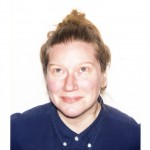
Jeanine Oleson is a visual artist with a growing interest in performance and opera. She attended the School of the Art Institute of Chicago and Rutgers University. Oleson has exhibited and performed at venues including: New Museum, NY; Exit Art, NY; Beta Local, San Juan, Puerto Rico; X-Initiative, NY; Grand Arts, Kansas City, MO; Commonwealth & Council, CA; Socrates Sculpture Park, NY; Diverseworks, Houston, TX; L.A.C.E., Los Angeles; Monya Rowe Gallery, NY; Samson Projects, Boston, MA; MoMA/P.S.1, NY; Pumphouse Gallery, London; White Columns, NY; and Art in General, NY. Oleson received a Franklin Furnace Fellowship and a Jerome Foundation Travel and Study Grant (2009), a Brooklyn Arts Council Community Arts Regrant (2008 and 2009), and a Professional Development Fellowship through College Art Association (1999–2000). She was in residence at the New Museum, Skowhegan School of Painting and Sculpture and Smack Mellon Studio Program. She also published two books about performance projects in 2012 — “What?” and “The Greater New York Smudge Cleanse.” Oleson is an Assistant Professor at Parsons the New School for Design. She lives in Brooklyn, NY, and was a member of the Civilians' 2013-2014 R&D group. www.jeanineoleson.com
View all posts


